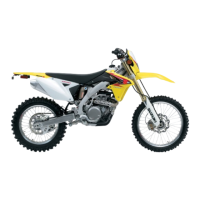Engine General Information and Diagnosis: 1A-2
Compensation of Injection Time (Volume)
The following different signals are output from the respective sensors for compensation of the fuel injection time
(volume).
Injection Stop Control
Signal Descriptions
ENGINE COOLANT TEMPERATURE SENSOR
SIGNAL
When engine coolant temperature is low, injection time (volume)
is increased.
INTAKE AIR TEMPERATURE SENSOR SIGNAL
When intake air temperature is low, injection time (volume) is
increased.
BATTERY VOLTAGE SIGNAL
ECM operates on the battery voltage and at the same time, it
monitors the voltage signal for compensation of the fuel injection
time (volume). A longer injection time is needed to adjust injection
volume in the case of low voltage.
POWER SUPPLY VOLTAGE SIGNAL
ECM operates on the power generation voltage and at the same
time, it monitors the voltage signal for compensation of the fuel
injection time (volume). A longer injection time is needed to adjust
injection volume in the case of low voltage.
STARTING SIGNAL When starting engine, additional fuel is injected during cranking
engine.
ACCELERATION SIGNAL/ DECELERATION
SIGNAL
During acceleration, the fuel injection time (volume) is increased
in accordance with the throttle opening speed and engine rpm.
During deceleration, the fuel injection time (volume) is decreased.
Signal Descriptions
TIP-OVER SENSOR SIGNAL (FUEL SHUT-OFF)
When the vehicle tips over, the tip-over sensor sends a signal to
the ECM. Then, this signal cuts OFF current supplied to the fuel
pump, fuel injector and ignition coil.
OVER-REV. LIMITER SIGNAL
The fuel injector stops operation when engine rpm reaches rev.
limit rpm.
NOTE
The fuel cut-off circuit is incorporated in this ECM in
order to prevent over-running of engine. When engine
speed reaches 12 000 r/min, this circuit cuts off fuel at
the fuel injector.

